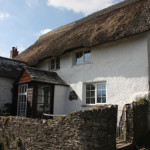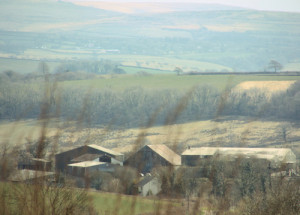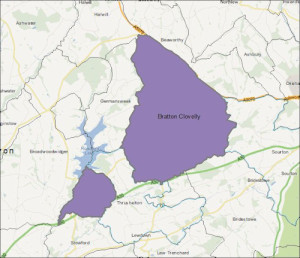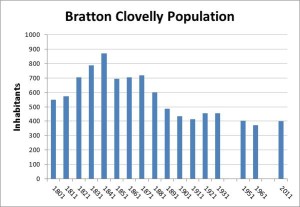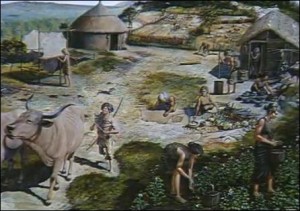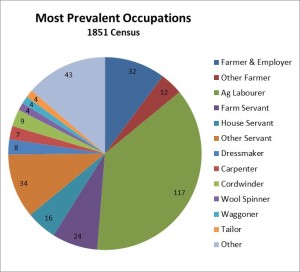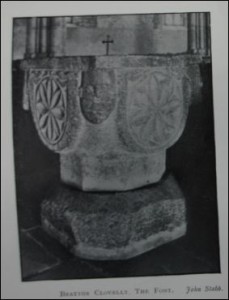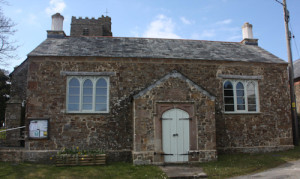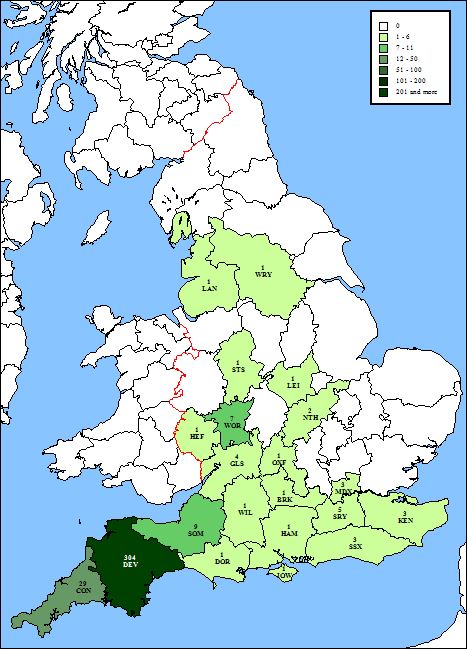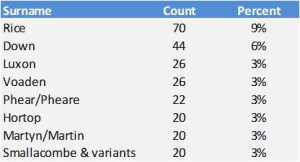Introduction
Bratton Clovelly is a picturesque parish in the Lifton Hundred of West Devon, brimming in history and a continuity that results in modern-day farms being traceable to medieval times. It is a sprawling rural parish centred on Bratton Village, with about 400 inhabitants maintaining a busy parish life to this day. The continuity of place is also reflected in the extensive records that have survived through the centuries for the people and properties of Bratton Clovelly, making it a treasure trove for local history and genealogical study. This place profile will continue to develop as we learn more about the parish.
Geography
Bratton Clovelly was historically a parish of about 8,000 acres, situated nine miles west of Okehampton, ten miles east of Launceston and the River Tamar and thirteen miles north of Tavistock. The landscape is one of green, rolling meadows, pastures and fields with the rugged Dartmoor looming in the east. The environment was radically changed in 1989 with the opening of the massive Roadford Reservoir that provides most of the freshwater supply to Southwest England but encroaches upon the western points of the parish.
At least since early medieval times, the parish was formed of two detached parts. The larger part of the parish to the east includes Bratton Village while the smaller part of the parish, separated by an area of Thrushelton parish, runs west to the River Wolf that feeds Roadford Reservoir. In 1885, a boundary change re-assigned the land and 63 inhabitants of the smaller part of Bratton Clovelly parish to Broadwoodwidger.
The soil is clay and the subsoil is clay, making the land challenging for arable crops but well-suited for the sheep and cattle still seen grazing in present times. Even so, the tax assessors found ample opportunity for the land to support crops, assessing half the acreage as arable in the 1845 Tithe Assessment.
Population
The earliest population substitute information that I currently have for Bratton Clovelly is the 1674 Hearth Tax, where 81 heads of household are listed. Eventually, parish registers which date back to 1555 may help to further quantify population in this period, but the first direct population measures for the parish itself begin in 1801 and are available from Historical Population Reports. In that year, 84 families were reported with a total population of 548. This number grew rapidly through the first half of the 1800s to reach a peak of 870 in the 1841 census but then declined just as rapidly to 436 in 1901 and reached relative stability around 400 for the latter half of the twentieth century.
Although more evidence is required, it seems likely that the rise and fall may have been related to the wool and textile industry in this area of the country. While the northern mills of the Industrial Age, closely located to the resources that fuelled them, achieved dominance in the textile markets, Devon’s growth centred more on the fast developing Plymouth maritime activity than the farming communities. Another contributor to the declining population in Bratton Clovelly itself was the 1885 boundary change that assigned the detached western part of the parish to another jurisdiction.
The parish of Bratton Clovelly is primarily comprised of farms, with approximately one-fifth of the population residing in Bratton Village through the nineteenth century. In addition, there were and still remain small communities at Boasley and Rexon Cross.
History
One of the exciting aspects of the Roadford Reservoir development is that it led to archaeological excavations in this part of Devon before the water overtook the settlements along the River Wolf. A brilliant documentary on the finds is available to UK viewers at Channel 4 on Demand, where you’ll notice Mick Aston in this series which pre-dates the popular ‘Time Team’ programmes. The team determines that there were permanent settlers in the area from about 4,000 to 5,000 years ago and steps through discoveries up to recent times, including artists’ depictions of the area in neolithic times as well as the nineteenth century. They also film a detailed excursion into the fascinating Church of St Mary the Virgin at Bratton Clovelly.
In Roman times, a fort was built at Broadbury on the northern edge of the parish, referred to as ‘Broadbury Castle’. Unfortunately, a farmer paid £14 in 1872 to have the remains levelled. Bratton is then mentioned in Anglo-Saxon times as a place of manumission, the freeing of slaves often by those professing their Christian faith. These manumissions frequently took place at crossroads and Bratton Clovelly has long been known as a place for travellers on such crossroads. By Domesday, three places in the parish are described including Bratton, Godescote which merged with the Bratton manor to become the detached western part of the parish, as well as Boasley situated on the eastern side of the parish.
By the fourteenth century, the parish name had evolved to Bratton Clovelly and a substantial number of manor rolls from 1377 to the seventeenth century promise to shed light on the medieval and Reformation periods. The first roll was translated long ago and, with the help of high quality digitisation by the Devon Record Office, I am in the process of having the remaining rolls translated over the next few years. The parish attracted a higher tax assessment than Okehampton in the fourteenth century but this area of Devon experienced population decline through the Middle Ages. The 1377 Manor Roll provides some evidence of the challenges faced when it reports that three workers were fined because they took excess pay against the 1351 Statute of Labourers which was intended to maintain wages at a level similar to those before the arrival of the Black Death. Fortunately, much is known about the ownership of Bratton manor during the medieval period from several sources, for example T. Whale’s excellent 1895 article, Manors of Bratton Clovelly.
Later times saw the continuation of the agricultural community. The parish remains vibrant today with farms that have stood for centuries. There are thirty listed buildings in the parish, including some with features dating back to medieval times. The remarkable parish church will be further described below, but there are also surviving farmhouses and buildings. The farms were far more practical than ostentatious, even though there were some very wealthy landowners in the parish including prominent ancient families.
Economy
Bratton Clovelly’s economy is founded on much the same activity in recent centuries as it was in medieval times. The 1377 Manor Roll provides insight, identifying court cases regarding oats being trampled by another’s cattle and mention of oxen and pack animals. Three innkeepers were fined for selling ale at prices contrary to the assize of Bread and Ale and in false measure as well. One guilty party cut down the Lord’s wood without licence and another was fined for not paying Alice Hethman for her work, highlighting an already diverse workforce.
Occupations and economic activity remained similar through the centuries, with 80% of the population of the parish still composed of agricultural families in 1801. Sheep, cattle and occasional dairy farms still make up the landscape today. Nineteenth century directories report that the crops of choice were wheat, oats and barley. Nineteenth century newspapers add further information, reporting the oak and ash timber sales, the annual licensing of gamekeepers and property advertisements with descriptions of dog kennels and stables for hunters to draw investors to the ‘sporting country of Broadbury.’
Occupational analyses of 1851 and 1911 show that, in both cases, about half of the workers in the parish continued in agriculture-related jobs while approximately a quarter of the workers were in domestic roles such as servants and cooks. Beyond that, there were the many smaller occupations anticipated in a busy community, such as tailors, dressmakers, postmasters, carpenters, clergymen and teachers. With time, the agricultural labourer population decreased as more individuals began to farm their own lands, more women engaged in work outside the home and more children attended school. Occupations like wool spinner disappeared to be replaced by rising trades such as railway work.
In the baptism and marriage records of today, one can still find the farmers. However, they’re now as likely to be neighbours of engineers, sales people and directors as of the agricultural labourers of earlier years.
Worship
The parish church, St Mary the Virgin, is a beautiful structure perched above Bratton Village. It welcomes visitors with a doorstep made of a Christian memorial stone and a twelfth century Norman font. Recently, restoration work was undertaken to ‘peel back’ layers of history, from seventeenth century wall paintings and text to sixteenth century whitewash back to medieval wall paintings. Stained glass windows highlight the Church’s benefactors, including the Burnaby, Pengelly and Manning families. The church is surrounded by a large parish cemetery with names familiar to the area for centuries.
Although the parish’s Episcopal Visitation Return of 1779 reported that ‘We have not any reputed Papists, nor dissenting Congregations’, by the mid-nineteenth century there were three Bible Christian Chapels in the parish. These chapels remained active throughout the century, eventually merging with the Methodist Church in the early 1900s. The Bratton chapel is now a private residence in Bratton Village but the other two chapels are still in use at Boasley and Rexon Cross.
Community Life
At least from the nineteenth century, Bratton Clovelly made use of the nearby towns of Okehampton especially but also Launceston and Tavistock for activities such as markets and commercial transactions. In addition, Okehampton was the seat of local government and associated institutions such as the Union Workhouse.
However, nineteenth century directories document twice yearly fairs in Bratton Clovelly and the opening of a racecourse at Broadbury Castle which hosted the ‘Broadbury Races’. Hunting was also popular in the area and up to three innkeepers were active at any given time. A school opened in 1837 and a new Board School was erected in 1877 to teach up to 140 children. There was regular transport and post, the local Post Office closing only a few years back.
Today, the village remains vibrant with its church and chapels, village hall, Boasley Primary School, Clovelly Inn and meeting facilities in the Old School Room. It hosts the Womens Institute, garden club, Christmas fayres, musical events, annual competitions and other local events catering for all ages.
Travel and Migration
Bratton Clovelly remains in a rural setting to this day. Through the nineteenth century, railway links arrived at the nearby villages of Ashbury and North Lew, post was transported by foot from Lew Down and the nearest telegraph office was at Lifton. Today, the busy A30 touches the edge of the parish but one still winds down long country lanes to the village in the shadow of raised banks carved by centuries of use.
While the steep rise in population of the early nineteenth century mirrors what was happening with the English population as a whole, the parish experienced a steep decline through the latter half of the century. Within the British Isles, migration into and out of the parish was mostly local. However, the net local migration does not appear to explain the large population loss and more investigation is needed to determine the extent of overseas emigration.
Families and Notable People
Baldwin the Sheriff held Bratton at the time of Domesday. Then, nineteenth century directories repeatedly report that the famed medieval lawyer, Henry de Bracton, was born in Bratton Clovelly but such a claim remains questionable. It is likely though that it was the birthplace of another of the same name who was Chancellor of Exeter Cathedral. Since that time, some of the most ancient and notable families in the southwest either resided in or owned land in the parish, names like D’Eaudon, de Meriet, de Somerton, Fraunceys, Pengelly, Langford, Burnaby, Calmady and Coryndon.
In his 1895 article Manors of Bratton Clovelly, T. Whale identifies the recurring surnames in the medieval Manor Rolls, in some cases associating them with the names of farms that can still be found today. White’s Directory of 1878 states that ‘at one time every farm had a resident of the same name’ although this statement is not yet proven. Some of the surnames and associated property names have Celtic origins such as Boasley and Maindea, while others show Anglo-Saxon and Norman influences. Such name research is a reminder that Devon was part of the Dumnonii tribe and Bratton Clovelly is positioned not only bordering one of the most western Roman outposts at Broadbury but also only a few miles from one of the last battles between the English Saxons and British Celts at Galford in 825.
Results from analysing seventeenth to twentieth century name sources identify the later enduring surnames of the parish, including for example Voaden, Metter, Down, Rice, Phear, Hortop, Luxton, Martyn and Smallacombe. However, through these later centuries it was a rarity for any one surname to ever account for more than 4% of the total sample and today’s inhabitants are highly diverse, with only three surnames accounting for more than 1% of the sample.
Further Reading
Sabine Baring-Gould, Red Spider, Chatto & Windus, Piccadilly (1887), available at Internet Archive.
W G Hoskins, Devon, Phillimore & Co Ltd, Andover, Hampshire (2003), first published in 1954 by Collins in the New Survey of England.
Robert Higham, Making Anglo-Saxon Devon: Emergence of a Shire, The Mint Press, Exeter (2008).
A Mawer & F E B Stenton (eds.), The Place-Names of Devon, Cambridge University Press (1931).
T Whale, ‘Manors in Bratton Clovelly’, Report and Transactions of the Devonshire Association for the Advancement of Science, Literature, and Art, Vol 27, presented at Okehampton, July, 1895, William Brendon & Son, Plymouth (1895), available at Internet Archive.
A History of Devonshire in Five Volumes, Vol 1, The Victoria History of the Counties of England, ed William Page, Dawson for the University of London Institute of Historical Research, Archibald Constable & Company Limited (1906), reprinted by William Dawson & Sons, Folkestone, Kent (1975). Note that the other four volumes have not yet been published.
‘Time Signs’, 4 episodes, Channel 4 on Demand.
Resources
| Property Taxes 1333-1873 | Local Newspapers 1779- | |
| Manor Rolls 1377-1685 | Voter Lists 1832-1935 | |
| Listed Buildings 14th-20th century | Censuses 1841-1911 | |
| Deed Documents 15th century- | Tithe Maps and Assessments 1845 | |
| Parish Registers 1555-2000 | Directories 1850- | |
| Wills and Probates 17th-20th century | School Records 1897-1961 | |
| Freeholder Lists 1711-1799 | Local History Books and Articles | |
| Military Records 1569-20th century | Various Maps |
Prepared by Kim Baldacchino
Nov 2013
